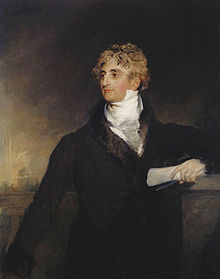User:Lord Cornwallis/Allied Occupation of France
| This is not a Wikipedia article: It is an individual user's work-in-progress page, and may be incomplete and/or unreliable. For guidance on developing this draft, see Wikipedia:So you made a userspace draft. Find sources: Google (books · news · scholar · free images · WP refs) · FENS · JSTOR · TWL |

The Allied Occupation of France lasted from 1815 to 1818 following Napoleon's final defeat at the Battle of Waterloo during the Hundred Days campaign. A multinational force, led by Anglo-Prussian forces, crossed into France and took the capital Paris. Allied troops then occupied much of France, until the Treaty of Paris on 20 November 1815 established a more limited occupation centred in the north of the country. Allied forces supported the restored Bourbon monarchy, and the British Royal Navy seized the deposed emperor Napoleon and exiled him to the island of Saint Helena.
The Duke of Wellington was appointed Commander of of all the Allied forces. He split his time between headquarters in Cambrai and Paris, where his presence was often required to lend support to the restored French regime in the face of continued Napoleonic and Jacobin threats. Wellington, nonetheless, attempted to keep Allied troops out of French domestic politics which featured a new constitutional monarchy.
The fashionable elite of several countries headed towards Paris, as they had in 1814 before Napoleon's escape from Elba. The song All the World's in Paris by British comedian Joseph Grimaldi caricatured the influx of fashionable dandies to the French capital.
Background[edit]
Following the Allied victories of 1813 at the Battle of Leipzig in Germany and Battle of Vittoria in Spain, Allied forces invaded France and by the spring of 1814 Napoleon was forced to abdicate. The exiled Louis XVIII was placed on the throne, and Napoleon was sent to Elba just off the Italian coast. The first Allied Occupation of Paris therefore ended relatively quickly and, after victory celebrations in London, Allied leaders headed to the Congress of Vienna to redraw the map of Europe. While Allied statesman were in Vienna, news arrived that Napoleon had escaped from Elba and retaken the French throne. British troops previously sent to liberate the Low Countries and allied Dutch forces were the closest to resist Napoleon's drive towards Brussels. Combining with Prussian forces under Marshal Blucher, the Duke of Wellington's army was able to defeat Napoleon at Waterloo and invade France. Other Allies including Austria and Russia were also gathering forces against Napoleon, and they joined the advance on Paris.
As British troops marched into Paris a regimental band played the popular, patriotic song "The Downfall of Paris", which Wellington quickly stopped, not wishing to offend the inhabitants. Allied leaders, including Metternich, the Tsar and Lord Castlereagh, gathered in Paris to draw up a new peace agreement. While the terms of the 1814 Treaty of Paris has been relatively generous to France, allowing the retention of several conquered territorities, the 1815 agreement was more punitive. It took away several stretches of conquered land, imposed a massive indemnity payment and established a large occupation army until France was considered no longer a threat. However, the British resisted the desire of their Prussian allies to execute Napoleon and instead sent him into exile on remote Saint Helena.
Occupation[edit]
A major source of contention was the looted art of Europe seized during Napoleon's campaigns, much of it now in the Louvre. While in 1814 France had been allowed to retain these artworks, after Waterloo the Allies began requisitioning these and returning them to their original owners. These included the Lion of Saint Mark returned to Venice, now under Austrian rule, and the quadriga of the Brandenburg Gate taken by Napoleon during the 1806 Fall of Berlin.
Amongst the French inhabitants great interest was shown in the Russian cossacks and the Scottish Highlanders of the British Army.
On the night of 10 February 1818, Wellington survived an assassination attempt in the Champs-Élysées when a pistol was fired at his carriage, which turned out to be part of a wider plot by Bonapartist exiles in Belgium. A former soldier Marie André Cantillon was arrested but ultimately acquitted by a French jury.[1] Despite the incident Wellington believed an early withdrawal would contribute to the growing stability of France, and remove a source of resentment amongst the population. He overcame opposition from the Secretary of War Lord Bathurst to persuade the British government to support ending the occupation early.[2]
Withdrawal[edit]

The Allied leaders met in the spa town of Aix-la-Chapelle planning to end the occupation and also invite France to join the alliance system, establishing a Quintuple Alliance of the Great Powers. The British artist Thomas Lawrence was commissioned by the Prince Regent to paint the various leaders of Europe at the Congress. A major factor was the early ability of the French to pay off the financial reparations imposed on them in 1815.
As the fifth of the great powers, France attended the subsequent international conferences of Laibach and Verona. At the latter in 1822 the Allied powers, with the exception of Britain, authorised France's military intervention in Spain.
References[edit]
Bibliography[edit]
- Haynes, Christine. Our Friends the Enemies: The Occupation of France after Napoleon. Harvard University Press, 2018.
- Muir, Rory. Wellington: Waterloo and the Fortunes of Peace 1814–1852. Yale University Press, 2013.
- Veve, Thomas Dwight. The Duke of Wellington and the British Army of Occupation in France, 1815-1818. Greenwood Publishing Group, 1992.
External links[edit]

